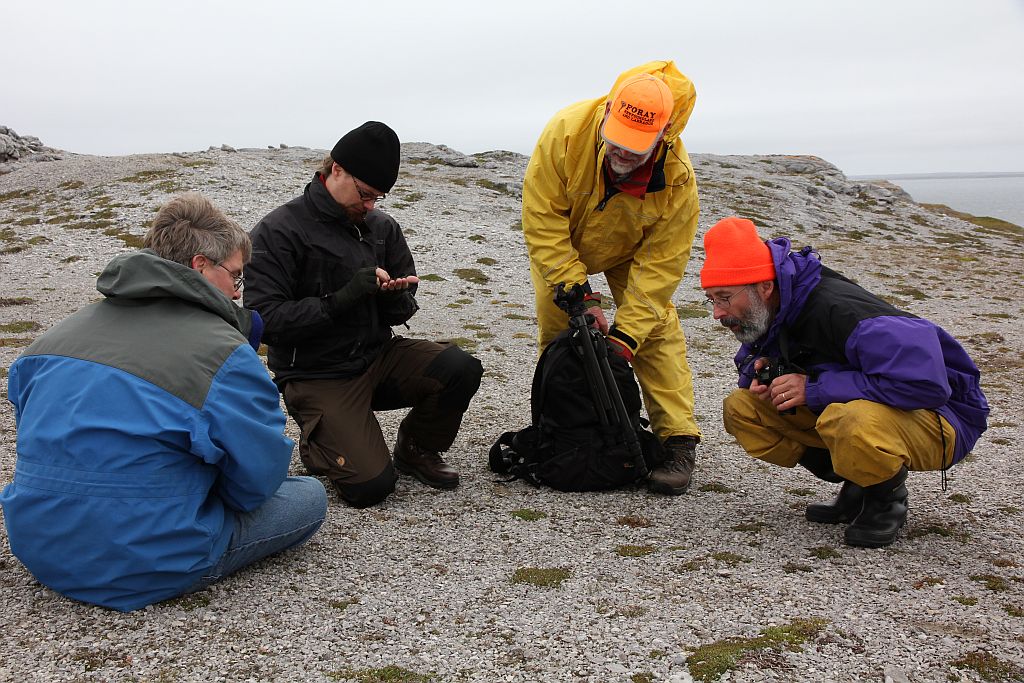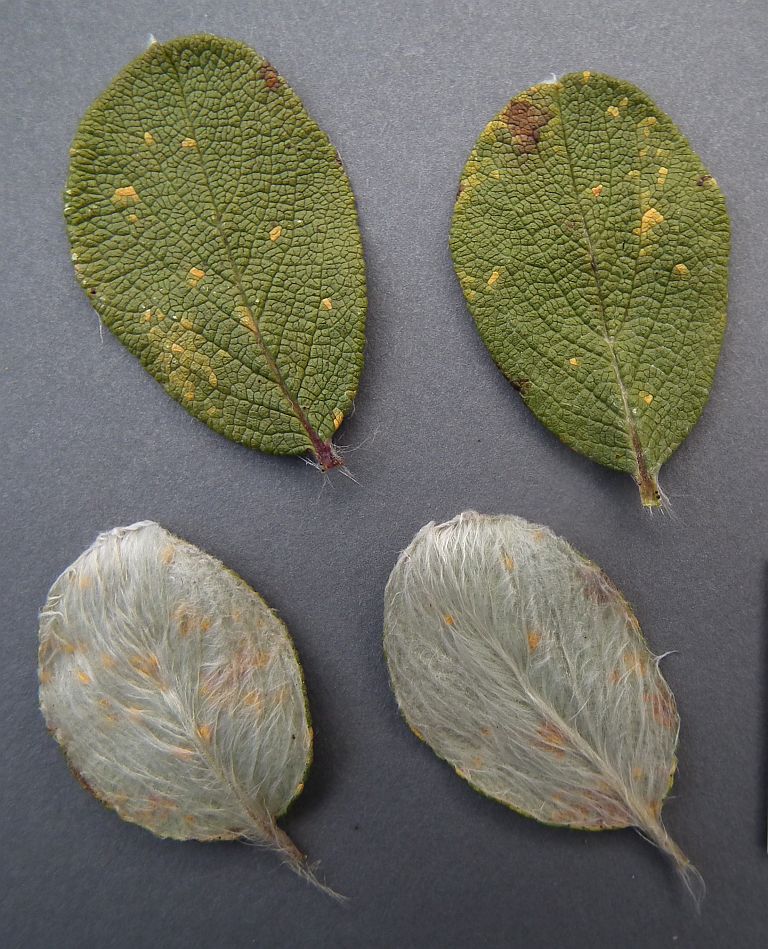We still have very little understanding of the fungi of our "Limestone Barrens".
However, during the course of the 2010
Mushroom Foray [click "DOWNLOAD" at lower edge of dark viewing area], one day was spent collecting on Burnt
Cape, and a list of 31 fungus species was compiled.

Collecting Fungi on Burnt Cape during the 2010 Mushroom Foray.
Photo: Roger Smith. [CLICK image to enlarge.]
Of the species on the 2010 list, the Yellow-foot Chanterelle Craterellus lutescens is known to prefer
calcareous soils.

Yellow-foot Chanterelle Craterellus lutescens . Photo: Andrus
Voitk. [CLICK image to enlarge.]
Also of interest was the Elfin Saddle
Helvella corium, which was found growing on the Cape in abundance. Elsewhere, it is usually found in gravelly
disturbed ground (pathsides and the like), often in association with calcareous stone
chips.

Elfin Saddle
Helvella corium. Photo: Andrus Voitk. [CLICK image to enlarge.]
Both of the above species were recorded only once at Burnt Cape, so they are certainly not overly common in the area.
Many fungi are "mycorrhizal", which means that
their "hyphae" (underground fungal filaments)
physically join onto or penetrate the roots
of vascular plants, and actively exchange fluids. Because mushrooms do not
have chlorophyll, they cannot make their own food, so absorbing nutrients (mostly sugars) from
vascular plants is a very useful life strategy.
However, "mycorrhizal" relationships are not one-way -
the extensive network of underground fungal filaments
also benefits the associated vascular plant by acting as a sort of extended root system
for obtaining extra moisture and mineral nutrients. On Burnt Cape, the plant partner of
Lactarius "deterrimus" is
Balsam Fir Abies balsamea, and the plant partner of Helvella corium appears to be
the Seaside Plantain Plantago maritima.

Lactarius "deterrimus". Photo: Andrus Voitk. [CLICK image to enlarge.]
Some fungi are simply parasitic.
In summer, the rust fungus Melampsora epitea parasitizes
the leaves of the Hairy Willow Salix vestita on Burnt Cape. But, rusts can have very complex life cycles, many
alternating between two completely unrelated host plants, over time. In winter, Melampsora epitea parasitizes Larch Larix sp.!

The rust Melampsora epitea on the Hairy Willow Salix vestita (note the
orange spots). Photo: Andrus Voitk. [CLICK image to enlarge.]
Also on Burnt Cape, rusts of the genus
Exobasidium
parasitize a number of common ericaceous (ie. heath) plants -
Exobasidium cassandrae on
Leatherleaf Chamaedaphne calyculata, Exobasidium karstenii on Bog Rosemary Andromeda polifolia var. glaucophylla,
and Exobasidium vaccinii-uliginosi
on Mountain Bilberry Vaccinium ulignosum. The effect of these rusts, on their ericaceous plant
hosts, can be dramatic - in the case of Exobasidium karstenii the host plant leaves become much broader and
the whole plant may turn various shades of pink!

The rust Exobasidium karstenii on Bog Rosemary Amdromeda polifolia var. glaucophylla.
Infected leaves are broad and pink. Photo: Andrus Voitk. [CLICK image to enlarge.]
Interestingly, the ericaceous plant hosts mentioned above actually prefer
acid soils, and
along with many other plants on Burnt Cape, and elsewhere on the "limestone barrens", they occur where sufficient
vegetative matter has accumulated to create an acidic layer over the limestone.
Some fungi are plant decomposers. Many of these are quite plant-specific. However, few seem to specifically target
limestone plants. That said, there
ARE species (not yet found in Newfoundland) that decompose the limestone-dwelling Mountain Avens (Dryas sp.).
One interesting thing about fungi is that it is an important degrader of "limestone" minerals. It thus
contributes to the longterm erosion of "limestone" bedrock and gravels.
[Page last updated: November 12, 2021]
...... ...... ...... ...... ...... ...... ...... ...... ...... ...... ...... ...... ...... ...... ...... ...... ...... ...... ...... ...... ...... ...... ...... ...... ...... ......
|
















